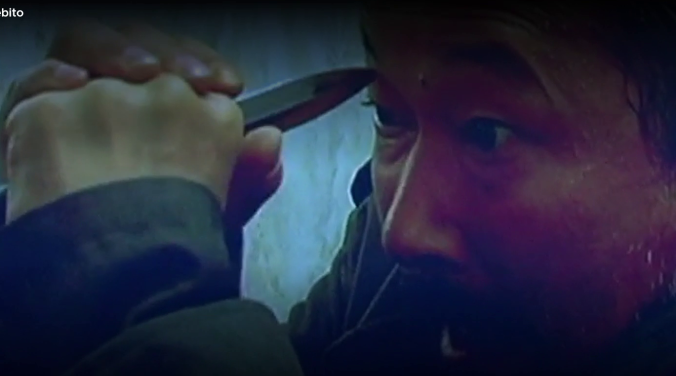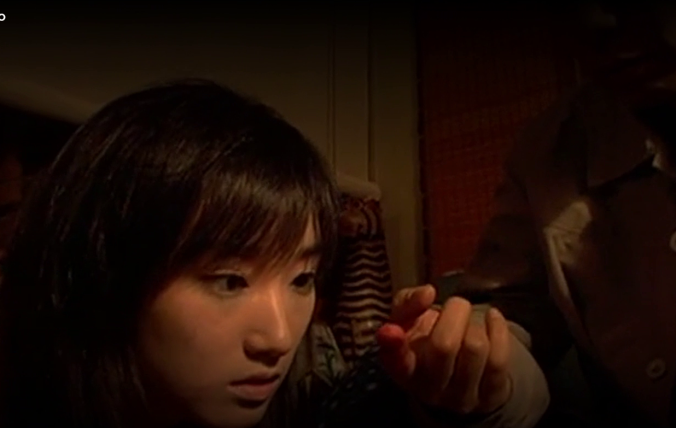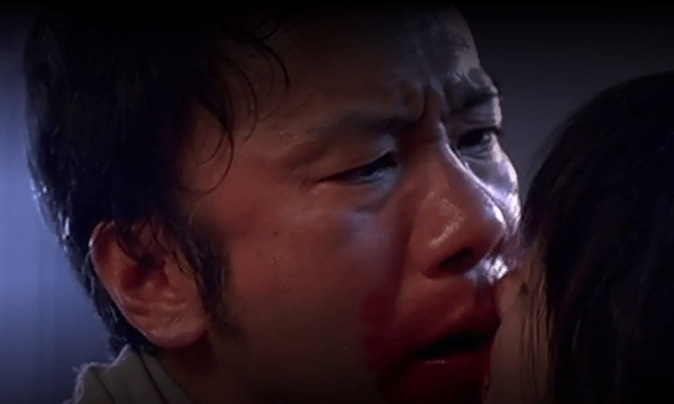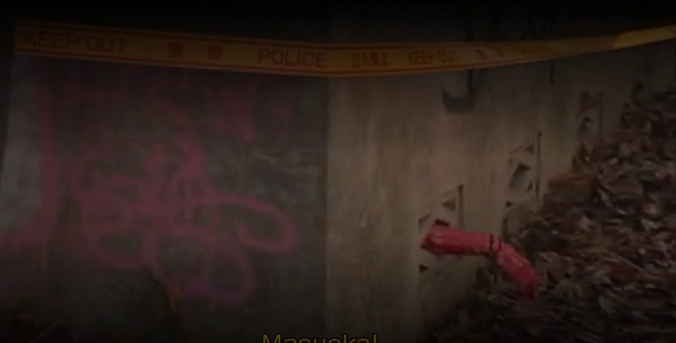 No one more personified 21st century J-horror than Takashi Shimizu, who wrote and directed the Ju-on movies. Even when not making Ju-on features, he almost never directed outside the horror genre which Ju-on had helped revive and re-define. Marebito is one of the rare exceptions.*
No one more personified 21st century J-horror than Takashi Shimizu, who wrote and directed the Ju-on movies. Even when not making Ju-on features, he almost never directed outside the horror genre which Ju-on had helped revive and re-define. Marebito is one of the rare exceptions.*
In many ways it looks like a Shinya Tsukamoto movie, not least because the main character Masuoka is played by Tsukamoto himself. Masuoka is a free-lance video cameraman, and his apartment is little more than a group of video screens on which he plays and replays things he has shot during the day. One day he happens upon a man committing suicide by stabbing himself through the eye. Masuoka wants to find not the thing that caused the man to kill himself but a chance to experience the same terror, perhaps to prove at last that he can feel something. This leads him into the maze of tunnels under Tokyo, where he finds a naked young woman chained in a recess. He brings her home, but she can not speak and is slowly wasting away because she will not eat or drink. That is, until he accidentally cuts a finger and discovers that she drinks blood. He goes on a murder spree to provide her with fresh blood, which she drinks from a baby bottle. He tries to run away but is drawn back to the apartment, where he cuts his mouth so she can drink his blood while kissing him and then follows her back underground to be with her and provide her sustenance.
He goes on a murder spree to provide her with fresh blood, which she drinks from a baby bottle. He tries to run away but is drawn back to the apartment, where he cuts his mouth so she can drink his blood while kissing him and then follows her back underground to be with her and provide her sustenance.
Though the European vampire concept is certainly present, the girl, which he calls “F” for no obvious reason, is not the Dracula kind of vampire who is constantly in search of its prey. (F is even taken for a walk in the bright sunshine, with her baby bottle along for a snack.) Much of the movie takes place underground, but this is not an underground where monsters lurk in the dark and leap out to attack the unwary loner. Rather, it is the underground of the Hollow Earth theory, popularized by Jules Verne and by Madame Blavatsky, but most famous in America through Richard Shaver’s Lemuria stories, which he claimed were factual. These are all mentioned by Masuoka, and many of the incidents we see can be traced back to Shaver’s stories of the post-war era, particularly the occasional glimpses of the Deros, the possibility of telepathy, and visions of the torture-murder of a young unidentified woman.
The real issue, however, is that Masuoka’s life is mediated by the camera. We first see a very primitive video image, full of the lines of low res TV. The picture clears to show him in his apartment, with the video we have been watching now playing on a computer screen and in turn being shot by a video camera. In the course of the movie we will see the movie-maker’s video of Masuoka, surveillance camera footage of his apartment, the scenes shown through his own camera, their projection onto his video screens, and then the video being taken of those screens. At times, we also seem to have an unknown observer taking fuzzy video of him as he goes outside. The movie thus has a dream-like state, but it is not a Masuoka’s dream – though there is a moment he seems to think so. It is a dream where reality doesn’t exist until it is photographed, and even then it is still unreal because it is only imagery.
There is gore for those who seek it, but after the eye stabbing, there is little attempt to shock the audience. We do not see the teenager’s murder, only her arm that slides through a gap in the wall.  Nor is there any attempt at titillation. Though F is found naked, he gives her clothing and once she is in his apartment he never even considers the possibility of sexual relations. She makes no attempt to communicate with him nor to hide from him. When he reviews the surveillance tape, she does not explore the apartment or try to figure out the computers; she spends most of her time sleeping, so deep at times that he thinks she is hibernating, To him she is a baby, a wild child like Kaspar Hauser, but one he can neither reach nor understand, no matter how detailed his observation.
Nor is there any attempt at titillation. Though F is found naked, he gives her clothing and once she is in his apartment he never even considers the possibility of sexual relations. She makes no attempt to communicate with him nor to hide from him. When he reviews the surveillance tape, she does not explore the apartment or try to figure out the computers; she spends most of her time sleeping, so deep at times that he thinks she is hibernating, To him she is a baby, a wild child like Kaspar Hauser, but one he can neither reach nor understand, no matter how detailed his observation.
Some scenes appear to be missing. Masuoka is suddenly shown coming out of a different apartment than the one we have seen throughout the movie, and later he refers to having murdered his wife and daughter, whom we have never seen as such. He wakes up sleeping in a cardboard box in a homeless camp outside the public toilet where he killed the teenager with only the comment that “I am not mad after all.” But this may all be a part of the dream-like aspect of the movie’s presentation. Though the original story by Chiaki Konako, who usually wrote for animated children’s TV, provides a setting and characters that can most often be found in fantasy and horror films, Shimizu in his direction turns this in a more intellectual direction, more in the realm of Kurosawa’s Pulse or Charisma than in his own Ju-on movies.
* The other is a live action version of Kiki’s Delivery Service.